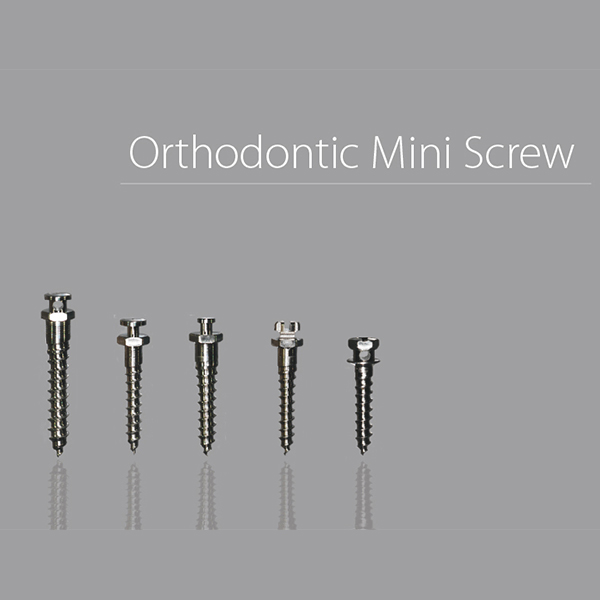What is an orthodontic mini-screw?
It is a small (diameter 1.2-2.0mm) screw device which is inserted (screwed) into the jaw bone through the gum to control tooth movement during orthodontic (braces) treatment. Mini-screws are made from either titanium or titanium alloy, hence are biocompatible. They are also known as mini-implants or temporary anchorage devices (TADs).
Mini-screws are derived from bone fixation technology. They primarily rely on mechanical retention rather than osseointegration. In other words, the screw stays in the bone through physical interlocking of the screw thread and bone. There is no biological bonding with bone. Therefore, mini-screws can be immediately loaded and easily unscrewed for removal at any time after insertion. Mini-screws are temporarily fixed to the bone to provide skeletal or absolute anchorage. Anchorage is the property that allows forces to be applied to move teeth. These forces are stabilized by the mini-screw acting as anchorage points.

Why do I need to have a mini-screw?
Orthodontic treatment is used to correct uneven or crooked teeth by moving the affected teeth into the correct position. Teeth are straightened by using a brace (orthodontic appliance). Sometimes unwanted or undesirable tooth movement may occur and compromise the treatment result. Several methods have been developed to stabilize these (anchor) teeth using devices attached to braces from inside and/or outside the mouth.
Mini-screws has been incorporated into orthodontic treatment, to provide a stable structure for anchoring various types of tooth movement. It has been used in a variety of cases including correction of large overjet (upper front teeth sticking out), deep bite (greatly increased overlap of lower teeth), open bite (upper and lower front teeth not touching), aligning buried (unerupted) teeth and closing of space. It has also been utilised to treat bite problems associated with jaw discrepancy (jaw size mismatch), which previously had to be treated by jaw surgery. The development of mini-screws has improved the efficiency and scope of orthodontic treatment.
Mini-screws are frequently placed between the roots of teeth and occasionally in the roof (palate) of the mouth. They will be attached to the fixed braces, and acts as anchor points to allow precise tooth movement to occur during treatment.
The use of mini-screws has gained popularity because they are less bulky, easily inserted and does not depend on the patient’s compliance.
How will a mini-screw be placed?
A mini-screw can be inserted at any time during the braces treatment by the orthodontist. Before the placement of mini-screws, a local anesthetic agent will be administered to numb the gum at the site of screw placement. Topical anesthetic gel can also be applied to the surface of the gum prior to injection to reduce the discomfort.
Patient is advised to rinse the insertion site with 0.2% chlorhexidine gluconate mouthwash for one minute. This is to reduce the amount of bacteria at the site of insertion and minimize the risk of infection.
The insertion of mini-screws can be performed with or without prior drilling, depending on the insertion site and the type of mini-screw. A self-drilling mini-screw may be inserted directly through gum and into the bone without drilling. However, when the use of self-tapping mini-screw or insertion into the thicker bone is necessary, a pilot hole may be drilled into the jaw bone prior to insertion. This is to facilitate mini-screw insertion by reducing the risk of screw fracture. For some screws, a cut in the gum and exposure of the bone is required to aid insertion.
Mini-screws can be attached with the brace immediately after insertion or at a subsequent visit.
Will it be painful?
Patients may experience a dull pressure sensation when the mini-screw is inserted. Once the numbness wears off they may feel some discomfort within the first 24 hours and it is self-limiting. Taking mild painkillers (such as paracetamol, ibuprofen) may relieve the discomfort. The area of the screw location may be sensitive to touch for a day or two.
Post-operative Care instructions
After the procedure, the surrounding gum must be kept clean and healthy to ensure the longevity of the mini-screw. Plaque (food debris) accumulation near the screw can cause inflammation and infection, which can lead to failure of the mini-screw.
They are advised not to “fiddle” with the screw with their fingers or tongue.
The use of an electric toothbrush around the mini-screw is not encouraged. Instead, the patient should gently brush around the mini-screw twice daily using fluoride toothpaste and a toothbrush with a small head. Rinsing with a chlorhexidine mouthwash twice daily for the first 5 days may be required.
The majority of the mini-screws remain stable (does not loosen) during brace treatment and cause little irritation or discomfort. However, they can become loose some occasions and warrant a removal or replacement. Placement of a small amount of orthodontic wax over the head of the mini-screw can help to reduce the discomfort due to any prominent surface or edges.
Patients are advised to contact their orthodontist if they experience any of the following symptoms: continuous bleeding, swelling, pain or discomfort at the insertion site.
Mini-screw failure
Mini-screws can become loose immediately after insertion or after 1-2 months. It can be replaced (reinserted) in the same position at later visit or in a different location. The success rate of mini-screw utilization is greater than 80 per cent as reported in the literature.
Soft tissue problems
The tissue adjacent to a mini-screw head may be injured especially if the screw has prominent or sharp edges. Peri-implant infection is usually superficial and self-limiting. Acute infections are rarely seen and readily resolved by antibiotics or immediate removal of the screw. Studies have shown that inflammation of the soft tissue is associated with a 30% increase in the failure rate of the mini-screw.
How long will the mini-screw be in my mouth?
The orthodontist will determine how long the mini-screw will be required. In most cases they will be in place for a few months until the desired tooth movement has completed. If there is any doubt over future anchorage requirements they can also be left in-situ for several months.
Mini-screws can be easily removed, usually without the need for local anesthesia. No special post-removal precautions (e.g. suturing or pain killer) are required. Both the gum and bone will heal up within several days without any problems.

